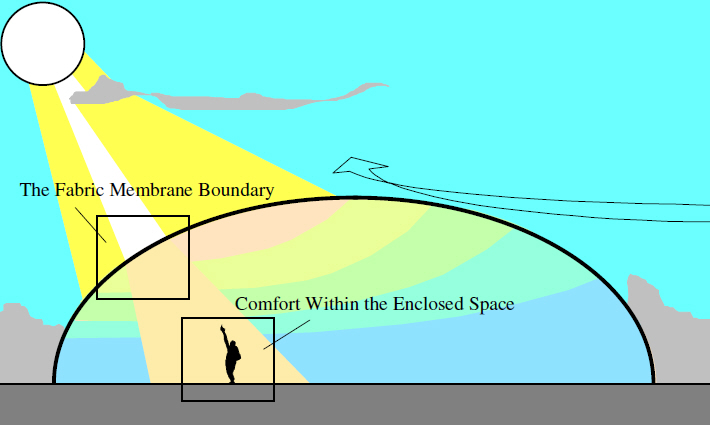The thermal behaviour of spaces enclosed by fabric membranes
A thesis submitted to the University of Wales for the degree of Philosophiae Doctor by GREGOR HARVIE. Welsh School of Architecture, University of Wales College of Cardiff, March 1996.
The findings in brief:
- Boundary models and CFD models need to be dynamically linked to properly represent the impact of thin boundaries whose temperatures can change very rapidly and very significantly (up to 15°c in a minute simply as a result of the sun coming out).
- Analysis of comfort must include radiant temperatures as well as air temperatures, particularly in spaces where there is a significant difference in temperature between the air in the space and the surfaces enclosing it, or where solar radiation penetrates the space.
- The difference in temperature between thin boundaries and the air they enclose, combined with smooth surface geometry results in a higher surface air velocity than is found in conventional spaces. This is similar to the downdraft generated by a cold window.
- Where there is likely to be a significant difference in temperature between a boundary and the air adjacent to it, a very small cell size (40 mm or less) is required to properly simulate the increased surface air velocity at that surface and so the increased surface heat transfer. Failure to properly simulate this will result in an underestimation of the contribution the boundary makes to internal conditions.
- In non-cartesian spaces (i.e. where surfaces are not all vertical or horizontal, but may be inclined or curved) it is necessary to use a body-fitted cell grid (i.e. one in which the grid is distorted to follow the contours of the surface) to allow a small enough cell size adjacent to boundaries to properly simulate the flow of air across those boundaries. If a cartesian grid is used, a refined grid is required throughout the space just to simulate the flow of air across the non-cartesian boundaries and this is computationally impractical.
 This thesis describes a programme of research the aim of which was to investigate the thermal behaviour of spaces enclosed by fabric membrane envelopes.
This thesis describes a programme of research the aim of which was to investigate the thermal behaviour of spaces enclosed by fabric membrane envelopes.
Initial analysis suggested that a fabric membrane can affect conditions within a space enclosed by it as a result of its internal surface temperature and the amount of radiation it directs into that space. In order to investigate these parameters, a test cell was constructed which allowed the thermal behaviour of a range of fabric membranes to be monitored.
The monitored data revealed that the thermal behaviour of fabric membranes is entirely dictated by their angular thermal optical properties. These properties were measured and a dynamic spread sheet model was developed which was able to simulate the monitored behaviour fairly accurately.
In order to investigate the thermal behaviour of spaces enclosed by such membranes, conditions within four existing fabric roofed buildings were monitored. The monitored data revealed that comfort temperatures could vary significantly from place to place within such spaces. These variations were produced by both the stratification of internal air temperatures and differences in internal radiant temperatures.
An attempt was made to simulate the behaviour of the buildings monitored, using a general applications CFD code in conjunction with information generated by the spread sheet model. Whilst some behaviour patterns could be simulated accurately using this approach, it was apparent that the simplification of boundary conditions in the CFD code meant it was unable to accurately predict strong internal stratification.
It was proposed that improving the reliability of this process would require the development of a specialist CFD model able to dynamically simulate both the behaviour of the fabric enclosure and the internal space.
- File:Contents.pdf. Contents.
- File:Chapter 1.pdf. Introduction.
- File:Chapter 2.pdf. Subject Background.
- File:Chapter 3.pdf. The Existing Body of Knowledge.
- File:Chapter 4.pdf. Methodology.
- File:Chapter 5.pdf. Monitoring the Thermal Behaviour of Fabric Membranes.
- File:Chapter 6.pdf. Measuring the Thermal Properties of Fabric Membranes.
- File:Chapter 7.pdf. Modelling the Thermal Behaviour of Fabric Membranes.
- File:Chapter 8.pdf. Monitoring the Thermal Behaviour of Spaces Enclosed by Fabric Membranes.
- File:Chapter 9.pdf. Modelling the Thermal Behaviour of Spaces Enclosed by Fabric Membranes.
- File:Chapter 10.pdf. Discussion.
- File:Chapter 11.pdf. Conclusions.
- File:Appendices.pdf. Appendices.
--Gregor Harvie 05:36, 22 May 2014 (BST)
[edit] Related articles on Designing Buildings Wiki
- Architectural fabrics.
- Computational Fluid Dynamics.
- Computational fluid dynamics in building design: An introduction FB 69.
- Dynamic façade.
- ETFE.
- Fabric structures.
- Frei Otto.
- Integrating CFD into the design process.
- Khan Shatyr Entertainment Centre.
- Millennium Dome.
- Sustainability.
- The building as climate modifier.
- The history of fabric structures.
- The structural behaviour of architectural fabric structures.
- Thermal behaviour of architectural fabric structures (updated version of this research).
- Thermal comfort.
- Transparent insulation materials.
- U values.
Featured articles and news
RTPI leader to become new CIOB Chief Executive Officer
Dr Victoria Hills MRTPI, FICE to take over after Caroline Gumble’s departure.
Social and affordable housing, a long term plan for delivery
The “Delivering a Decade of Renewal for Social and Affordable Housing” strategy sets out future path.
A change to adoptive architecture
Effects of global weather warming on architectural detailing, material choice and human interaction.
The proposed publicly owned and backed subsidiary of Homes England, to facilitate new homes.
How big is the problem and what can we do to mitigate the effects?
Overheating guidance and tools for building designers
A number of cool guides to help with the heat.
The UK's Modern Industrial Strategy: A 10 year plan
Previous consultation criticism, current key elements and general support with some persisting reservations.
Building Safety Regulator reforms
New roles, new staff and a new fast track service pave the way for a single construction regulator.
Architectural Technologist CPDs and Communications
CIAT CPD… and how you can do it!
Cooling centres and cool spaces
Managing extreme heat in cities by directing the public to places for heat stress relief and water sources.
Winter gardens: A brief history and warm variations
Extending the season with glass in different forms and terms.
Restoring Great Yarmouth's Winter Gardens
Transforming one of the least sustainable constructions imaginable.
Construction Skills Mission Board launch sector drive
Newly formed government and industry collaboration set strategy for recruiting an additional 100,000 construction workers a year.
New Architects Code comes into effect in September 2025
ARB Architects Code of Conduct and Practice available with ongoing consultation regarding guidance.
Welsh Skills Body (Medr) launches ambitious plan
The new skills body brings together funding and regulation of tertiary education and research for the devolved nation.
Paul Gandy FCIOB announced as next CIOB President
Former Tilbury Douglas CEO takes helm.
UK Infrastructure: A 10 Year Strategy. In brief with reactions
With the National Infrastructure and Service Transformation Authority (NISTA).

























Comments
To start a discussion about this article, click 'Add a comment' above and add your thoughts to this discussion page.